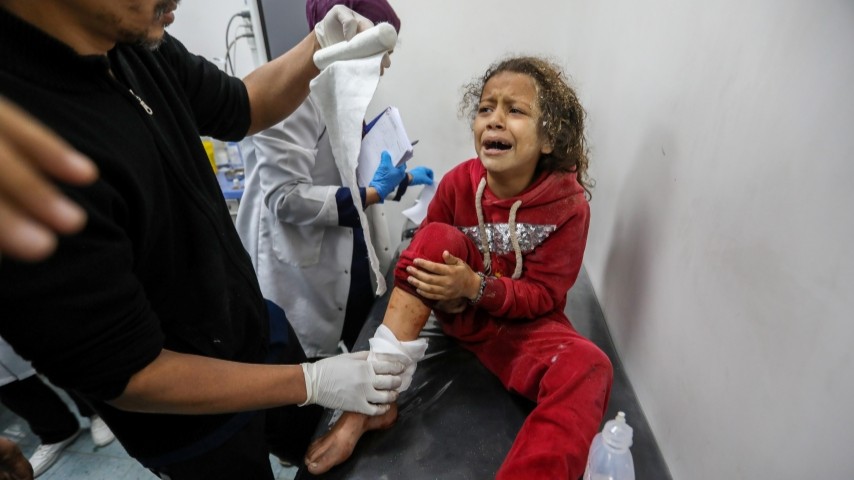Israel’s Attacks on Gaza’s Medical Infrastructure Have Created an Immense Health Crisis
Photo by Ahmad Hasaballah/Getty Images
Israel’s systematic destruction of all sectors of Gaza’s healthcare system has resulted in a worsening health crisis, culminating in more deaths and abject suffering. According to spatial analysis from research agency Forensic Architecture, between October 7, 2023, and August 1, 2024, 35 of 36 hospitals in Gaza were forced out of service due to Israel’s military campaign.
According to the United Nations Office for the Coordination of Humanitarian Affairs (OCHA), Israeli attacks have resulted in damage to at least 130 ambulances, and at least 14,000 patients now require medical evacuation outside of Gaza. The lack of access to medical care has resulted in a historic level of child amputations—the Strip is now home to the largest number of children amputees in modern history with OCHA reporting that “each day 10 children are losing 1 or both of their legs.”
Palestinian perseverance and ingenuity amidst immense Israeli brutality have helped patients survive their injuries, as overworked medical personnel struggle to face a tremendous workload and provide for the injured without the aid of antibiotics, anesthesia, and fuel. “It’s now rare for me to see a child with all their limbs,” a young woman in Gaza who did not wish to be named told Splinter. “Do people understand what that means? That the level of suffering is so great, that seeing a whole child is rare?” The overwhelming aggression of Israel’s campaign of genocide cannot be quantified, especially as Palestinians continue to literally pick up the pieces of their loved ones, many of whom cannot be identified, and as burial shrouds become more and more scarce.
As reported in a collaborative fact sheet project from Visualizing Palestine and MIFTAH, two mothers were killed every hour by Israeli forces during the first 100 days of the genocide in Gaza, and 3,000 women became widows between October 2023 and April 2024. The number of miscarriages in Gaza have increased by 300 percent, and 60,000 pregnant women face “genocidal conditions and lack of access to healthcare.” A staggering 19,000 children have been made orphans or “unaccompanied,” which has resulted in “the phenomenon of child-headed households” in Gaza.
Family medicine physician and public health practitioner Dr. Yipeng Ge, who spent a week in Gaza treating patients in February 2024, told Splinter that the healthcare infrastructure in Gaza has been “absolutely decimated.” “Initially, the hospitals and emergency rooms were completely overrun and over capacity with the number of patients they would be required to assess and treat due to the constant Israeli attacks on civilian life,” he said. “This led to the Ministry of Health in Gaza reaching out to the World Health Organization to bring in international healthcare workers to help support the local capacity of the healthcare system through the Emergency Medical Team (EMT) system. And thus international healthcare workers, primarily surgeons and anesthesiologists initially, were entering Gaza to help provide some additional coverage or respite for the local healthcare workers who had been working non-stop, many of whom working without stable pay or any pay whatsoever.”
Dr. Ge explained that while on assignment in Rafah and during his visit to the European Gaza Hospital in Khan Younis, which was coordinated through the organization Glia by way of the World Health Organization (WHO), he witnessed unlivable conditions including malnourishment, acute infections and burns as a result of Israeli airstrikes.
“The reason for these conditions presenting both in such high patient loads and severity, is the overlapping crises of food, clean water, and housing insecurity—none of which were available in the zones declared ‘safe’ by the Israeli army that we visited,” he said. “There are no ‘safe’ places left in Gaza.” Dr. Ge emphasizes that it’s imperative to understand that the Palestinian people of Gaza “did not choose to be heroes in this story of colonialism, but they were forced into it. As much as we all see how people are marked and their stories are told through the lens of a victim or of a hero, they are human just like you and I. Their bodies are of a human being like you and I. We should caution ourselves to not over-glorify their resilience and steadfastness or their immense suffering and losses.”
Dr. Ge, who says he left his heart in Gaza, emphasized the dedication of Palestinian healthcare workers to the community. “The only hot meals I ate in Gaza were because the colleagues I was with demanded that we share meals together, knowing how little they had, they still shared and still wanted to do more for us as their guests,” he said. “It broke my heart… It was also healing. To see humanity and life be taught by Palestinians. To see humanity and life be practiced by Palestinians, despite the ongoing genocide – and in the face of ongoing genocidal violence that could end their life any day. I [learned] more about life and humanity while in Gaza than I have throughout medical training or throughout my life thus far.”
According to a report from The Lancet, Israel has killed 3 percent of Gaza’s population; that finding, the researcher wrote, likely “underestimate[s] the full impact of the military operation in Gaza, as they do not account for non-trauma-related deaths resulting from health service disruption, food insecurity, and inadequate water and sanitation.”
In a post on Twitter a 28-year-old doctor in Gaza, Dr. Ezzideen Shehab, wrote that on the morning of January 9 his neighbors attempted to wake their 42-year-old mother, who had no health conditions, or chronic illnesses. “But just yesterday, her sister was killed in an airstrike in northern Gaza. Four days before that, her brother met the same fate. Today, sorrow and heartbreak claimed her life. Every day, we lose mothers, fathers, and children, not only to bullets and bombs but to the cold, to despair, to grief.” He ended his post with a final plea: “Stop this war. Please.”